Laser cutting is closely related to the following factors:
① Nozzle status
Nozzle diameter, nozzle integrity or damage, nozzle height if installed in place
② Condition of the ceramic ring
Is the ceramic ring intact or damaged and the state of the connection between the ceramic ring and the sealing ring.
③Cutting head, optical path status
Whether the collimating mirror, focusing mirror, or protective mirror are polluted and whether the optical path is coaxial with the nozzle
④ Auxiliary gas
Auxiliary gas purity, auxiliary gas flow, auxiliary gas pressure
⑤ Focus position
⑥ Cutting speed
⑦ Laser power
⑧ Board quality
Plate material, plate thermal deformation, plate surface quality (rust, foreign bodies, etc.)
Among the above cutting influencing factors, we should pay attention to four of them:
- Cutting speed
- Laser power
- Focus position
- Auxiliary gas pressure
Changes in other factors also directly or indirectly affect these four factors.
We will give a detailed introduction below.
Effect of nozzle on laser cutting quality
The nozzle type, nozzle opening, nozzle integrity, nozzle height (distance between the nozzle outlet and the workpiece surface), etc., will affect the cutting effect.
Nozzle type and opening selection
Currently, the nozzles used are divided into single nozzles, double nozzles and short nozzles.
The single-cut nozzle openings are:
Φ0.8, Φ1.0, Φ1.5, Φ2.0, Φ2.5, Φ3.0, Φ3.5, Φ4.0;
The dual cutting nozzle openings are:
Φ0.8, Φ1.0, Φ1.5, Φ2.0, Φ2.5, Φ3.0, Φ3.5, Φ4.0;
The shortcut nozzle openings are:
Φ3.0, Φ3.5, Φ4.0
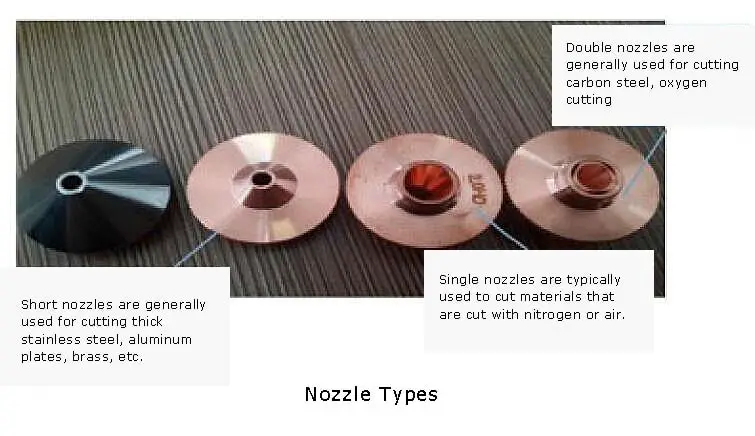
In principle:
The thin plate adopts the nozzle with small opening and the thick plate adopts the nozzle with larger opening.
Small toe cut:
The cutting surface will be thinner; when the thick plate is cut, the gas diffusion area is small, so it is not stable when used.
Big toe cut:
The nozzle with a small cutting section is slightly thicker; the gas diffusion area is large and the gas flow rate is slow, so it is stable during cutting.
Comparison of nozzle openings:
| Nozzle opening | gas flow | Cast removal capacity |
| small | fast | big |
| big | slow | small |
Effect of nozzle breakage on cut quality
During the cutting process, when the nozzle collides or rubs against the workpiece, the nozzle is easily deformed.
When drilling occurs in the hole or the cutting piece cannot be cut, the nozzle may melt and the nozzle mouth becomes blocked, which will affect the cutting quality.
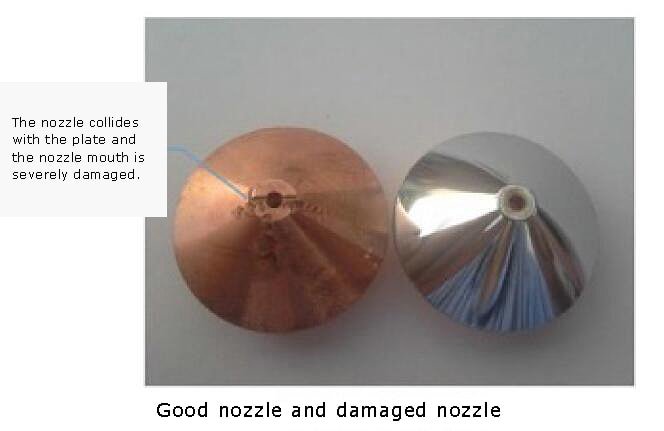
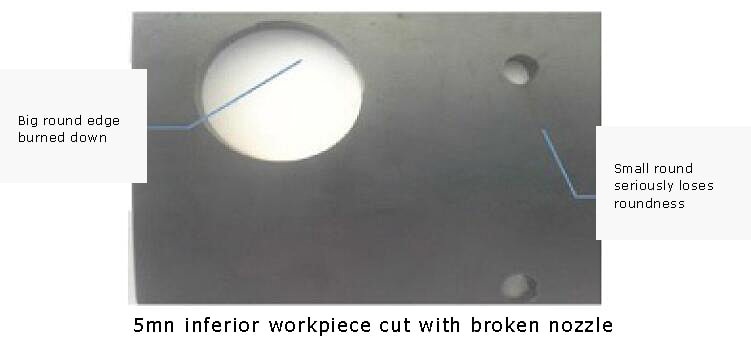
When the nozzle is deformed or melted, the following adverse effects will occur:
1). The nozzle and laser beam are on different axes
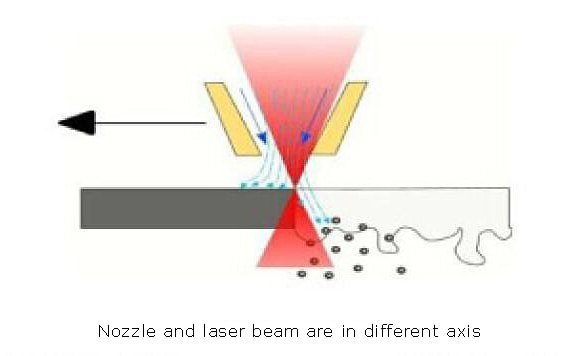
The coaxiality of the center of the nozzle exit hole and the laser beam is one of the important factors that affect the cutting quality.
The thicker the workpiece, the greater the impact.
When the nozzle is deformed or melted, it will directly affect the coaxiality.
Therefore, the nozzle must be carefully stored and installed correctly to avoid jolts and prevent deformation.
If it is necessary to change the conditions at the time of cutting due to the poor condition of the nozzle, it is best to replace it with a new one.
two). When the auxiliary gas is expelled from the nozzle, the amount of gas is not uniform and a phenomenon occurs in which one side melts or burns and the other side does not.
When cutting a thin sheet of 3mm or less, its influence is small; When cutting more than 3mm, the effect is serious and sometimes cannot be cut.
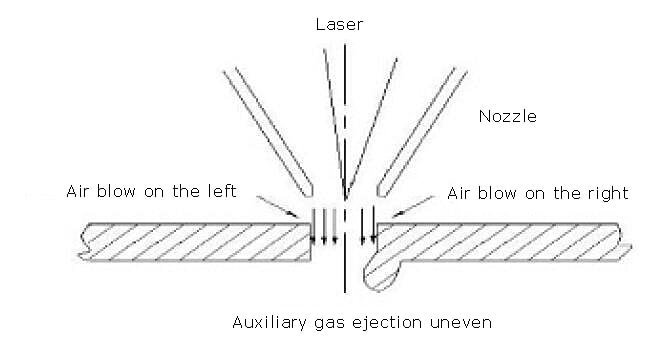
3)Impact on sharp corners
When the workpiece has a sharp corner or a small angle, excessive melting is likely to occur; thick boards cannot be cut.
4). Effect on drilling
The drilling is unstable, the time is not easy to control, the thick plate will melt too much, and the penetration condition is difficult to understand, and the influence on the thin plate is small.
The effect of nozzle and workpiece clearance on cut quality (clearance is the distance between the nozzle exit and the surface of the workpiece).
Clearance has a huge effect on cut quality, which is often overlooked during the cutting process.
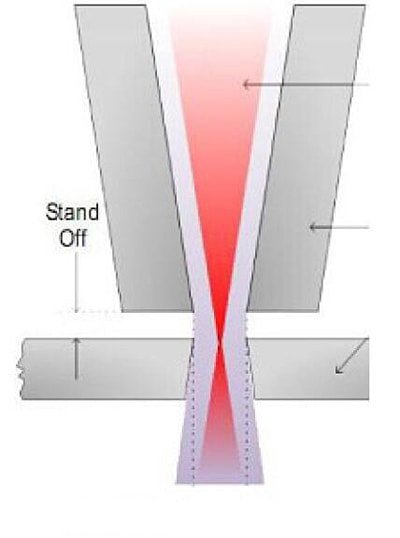
When cutting normally, the follower height should generally be 0.8mm to 1.2mm.
Too low will cause the nozzle to easily collide with the surface of the workpiece;
Too high will cause the nozzle airflow to disperse, resulting in a change in the concentration and pressure of the auxiliary gas, and then leading to a drop in cutting quality.
The change in nozzle height (up or down) also causes a change in focus position (up or down) which affects the quality of the cut.
The main factors affecting the height of follow-up:
- The nozzle surface detects metallic foreign materials on the plate surface or blasts slag during drilling, resulting in a large subsequent height change.
- The follow-up check is incorrect.
- Sensor failure is caused by damage to devices such as ceramic rings and sensor wires.
- The workpiece is lifted or the plate is thermally deformed and bowed
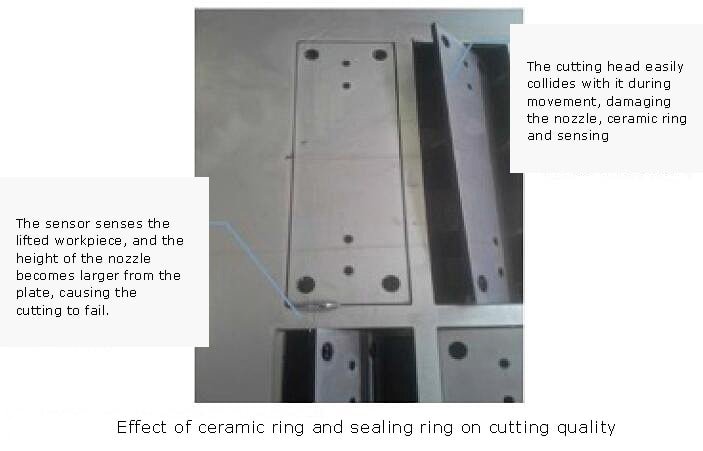
Effect of Ceramic Ring and Sealing Ring on Laser Cutting Quality
During the cutting process, when the cutting head collides with the lifted workpiece, it is easy to crack or pulverize the ceramic ring.
When the ceramic ring is cracked, the auxiliary gas leaks easily, resulting in insufficient flow of auxiliary gas and affecting the cutting quality.
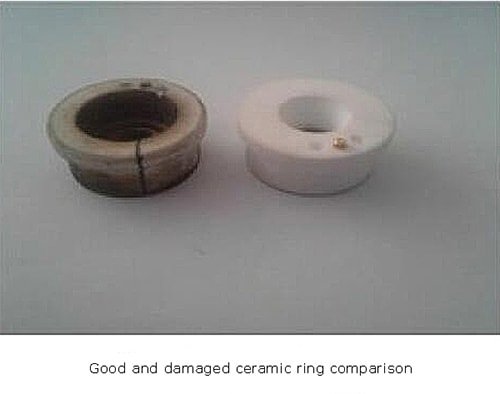
When the ceramic ring is broken, the operator must replace the new ceramic ring in time.
During the replacement process, care must be taken to ensure that the sealing ring between the ceramic ring and the cutting head is pressed and compacted.
Do not lose it, otherwise it may easily cause auxiliary gas leakage and affect the cutting quality.
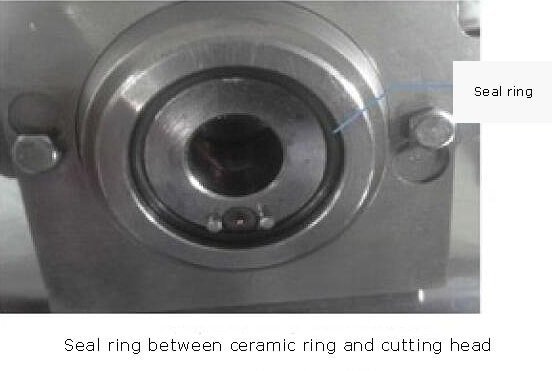
Effect of cutting head and optical path state on laser cutting quality
The main components of the cutting head are collimating mirrors, focusing mirrors and protective mirrors.
Any contamination of the lens can affect the light path, which affects the quality of the cut.
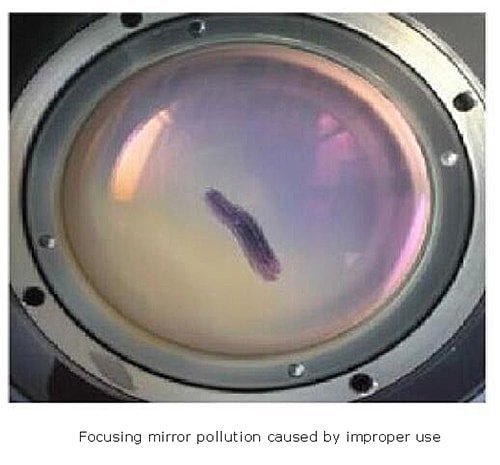
The different laser and nozzle axes also present optical path transmission problems, which can also lead to cutting failure.
Mainly in the following aspects:
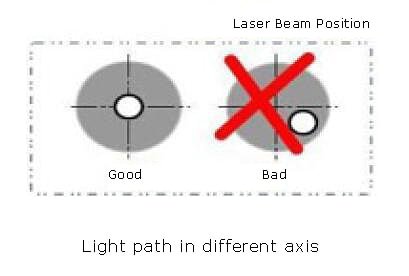
- The cutting effect of 3 edges of the workpiece is good, 1 edge is not good
- the edge of the piece is burnt, as shown below:
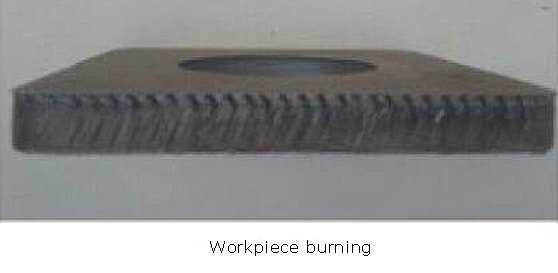
- the workpiece cannot be cut.
Effect of focus position on laser cutting quality
When cutting different materials, the focus position needs to be adjusted according to the different requirements of the cutting process.
The direction of the eccentric point position must be distinguished when a focus position parameter is provided.
We set the focus position to 0 on the top surface of the sheet.
The focus is negative below the top surface of the leaf and positive above the top surface of the leaf.
As shown below:
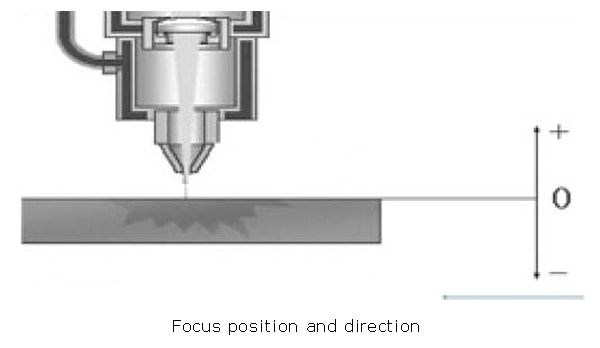
Focus position selection
The focus position is one of the four elements of the cropping process.
Therefore, it is necessary to determine whether the focus position is adjusted correctly according to different reference plates and process parameters before each cut.
The main factors that affect the focus position are:
- Factors that affect tracking height will affect focus position.
- Lens contamination will cause abnormalities in the optical path, which will also lead to energy transfer and changes in focus position.
- After replacing the collimating or focusing lens, the focus position may change and the engineer needs to check.
Effect of auxiliary gas on laser cutting quality
Effect of auxiliary gas species on the cutting process
When selecting the type and pressure of the cutting auxiliary gas, the following aspects must be considered:
- Generally, oxygen is used to cut common carbon steel, such as low pressure drilling and cutting.
- Generally, nitrogen is used to cut stainless steel, aluminum plate, brass, etc.; low pressure nitrogen for drilling, high pressure nitrogen for
Effect of auxiliary gas purity on the quality of cut products
(1) the effect of insufficient gas purity when cutting carbon steel with oxygen:
- For thin carbon steel sheets (l ~ 5 mm), the purity is insufficient and the gas flow rate must be increased during cutting.
- For thick carbon steel plates (6amm+), the gas purity requirement is very strict, and if the purity is insufficient, the cutting quality will be very poor or cannot be cut at all.
(2) the effect of insufficient gas purity when cutting stainless steel, aluminum plate, brass, etc. with nitrogen:
- For stainless steel and brass, the cross-section quality is poor and the cross-section is rough.
- For aluminum plate, the cross-section quality is poor and the slag is difficult to handle.
Effect of auxiliary gas pressure on cut quality
(1) The gas helps to dissipate heat and aid combustion, and blows away the melted surface, so that the cut surface has better quality.
(2) The effect on cutting when the gas pressure is insufficient:
- The cutting surface is melted or cannot cut
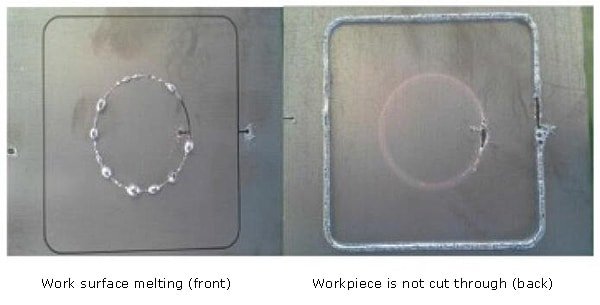
- The cutting speed cannot be increased, which affects efficiency.
(3) The influence on cutting quality when the gas pressure is too high.
- The cutting surface is thicker and the slit is wider.
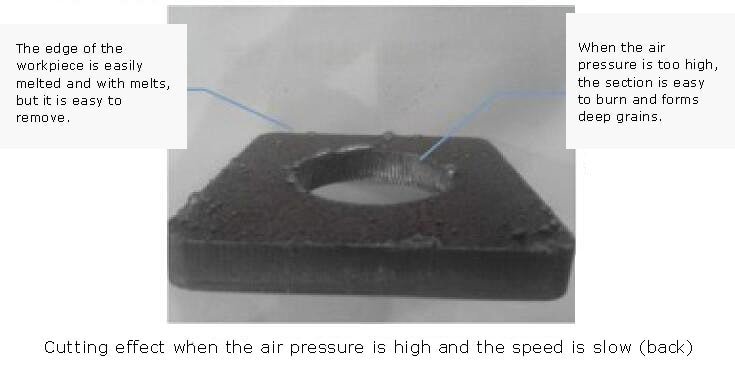
- The cut part melts and good cutting quality cannot be achieved.
Effect of auxiliary gas on drilling
(1) When the gas pressure is too low, it is not easy to cut and the time increases.
(2) When the gas pressure is too high, the hole is exploded, causing the penetration point to melt and form a large melting point.
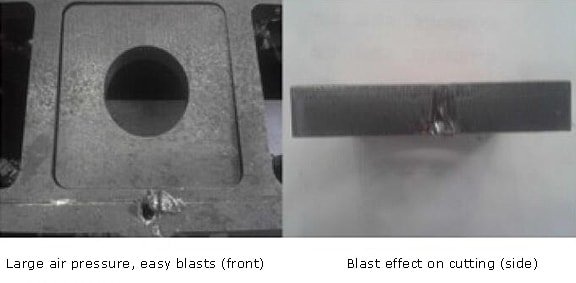
Therefore, generally for carbon steel sheets, the punching pressure of thin sheet is higher and the punching pressure of thick sheet is lower.
When the thick plate is drilled, the gas pressure and air ratio should be reduced appropriately when the hole is blasted and the drilling time increased.
Factors affecting auxiliary gas:
- Auxiliary gas purity
When the purity of the auxiliary gas is low, the pressure of the corresponding gas must be increased and vice versa.
- Nozzle opening
At a given pressure, the smaller the pore size, the smaller the flow rate; the larger the pore size, the higher the flow rate.
The flow size affects the cutting effect and the ability to remove melt.
- Nozzle height
The higher the nozzle is on the plate, the more dispersed the airflow will be; the lower the plate, the more concentrated the airflow.
The amount of flow affects the cutting effect and the ability to remove melt.
- Beak breakage
If the nozzle air outlet is damaged, the outgoing air flow will be uneven, which directly affects the cutting ability.
- Ceramic ring and its sealing ring
Damage to ceramic rings and seals can cause gas leaks, which in turn affect air pressure and flow.
- Cutting speed
The speed is too fast, so the auxiliary gas cannot remove the melt effectively, and then it will hang slag or fail to cut.
- Laser power
If there is a loss in laser power, more pressure will usually be required to remove the molten material.
- Focus position
If the focus is not correct, the laser energy on the board will be uncertain.
It can be understood that if the energy is a lot, the air pressure should be small; if the energy is low, the air pressure must be higher.
- Sheet quality
If the quality of the sheet is not good, it will directly affect the cutting;
If the sheet surface has rust, etc., which is not conducive to oxygen combustion and melt removal.
Effect of cutting speed on laser cutting quality
The effect of too fast cutting speed
(1) It may cause reverse spray and blunt phenomenon, see the figure below.
(2) Some areas can be cut, but some areas cannot be cut.
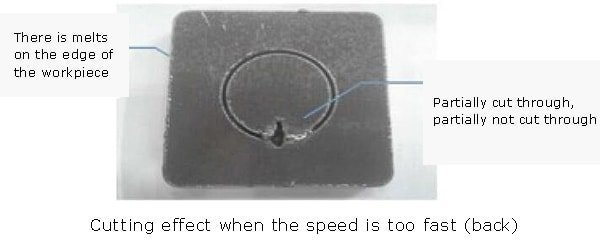
(3) The entire end face is thicker, but no fusion is generated.
(4) The cut section is shown as a cross grain and the lower half is melted.
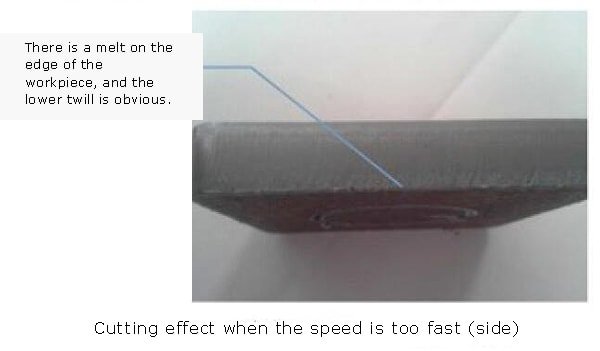
In general, the cutting speed is too fast, the gas pressure is low, and the power is low, and as a result, the cutting is insufficient.
Feed rate effect is too slow
(1) Excessive melting condition is caused and the cut end face is rough.
(2) The slit will also be widened and melted when the sharp corner is cut.
(3) Affecting cutting efficiency.
In general, the cutting speed is too slow, the air pressure is too high, and the power is too large, and as a result, the phenomenon of excessive cutting melting is caused.
Selection of appropriate feed rate
From the cutting spark, it can be determined whether the feed rate can be increased or decreased; when the correct cutting speed is set, the spark spreads from top to bottom.
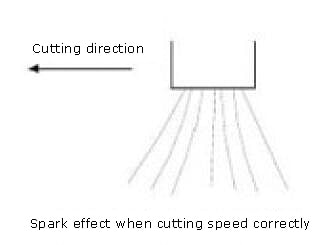
If the spark is skewed, the feed rate is too fast, the auxiliary gas does not completely eliminate the slag, and the cutting head has moved forward.
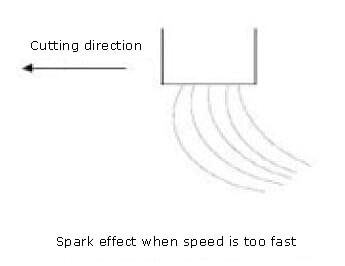
The sparks are not diffused and are smaller, and when they are condensed together, the speed is very slow and the auxiliary gas is blown excessively, so that the part section is easily rough.
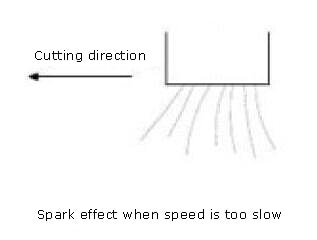
By adjusting the appropriate feed rate, the cutting surface shows a smoother, unmelted line at the bottom.
Effect of laser power (W) on laser cutting quality
- The laser power (W) is too small to be cut.
- The laser power (W) is too high and the entire cutting surface melts.
- The laser power (W) is insufficiently set and melt is generated after cutting.
- The laser power (W) is set correctly, the cutting surface is good and no melting is generated.
- Factors affecting laser power (W);
A) lens pollution
B) the focus position is incorrect
C) There are rust stains and oil stains on the board surface:
Effect of sheet type and quality on laser cutting quality
Most ferrous metals and non-metals can be laser cut.
Each material has its own unique response to the laser (1080u wavelength).
Whether any material is suitable for laser cutting depends on the interaction of the material with the laser wavelength and energy.
They achieve different cutting capacities, cutting speeds and cutting quality.
In general, the elements that affect the laser cutting ability of the material are:
- Surface condition
- Thermal diffusivity
- Conductivity
Material surface treatment such as aluminum-zinc, plating, coating, rusting, coloring, painting and protective coatings generally have a negative impact on laser cutting.
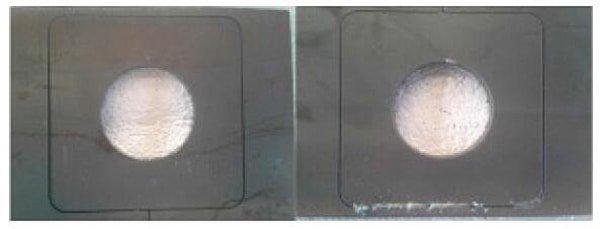
There are rust spots on the leaf surface (front) and the rust spots are not cut (back)
For boards with embroidered stains and oil stains on the surface, they should be processed first and then cut.
If it cannot be completely cleaned, consider reducing the cutting speed, increasing the auxiliary air pressure and increasing the power to prevent the sheet from being unable to be cut.
Laser cutting has the phenomenon of heat absorption and thermal diffusion, and the temperature of the material has a non-negligible influence on the quality of laser cutting.
In general, when the material temperature exceeds 90°C, it will have an adverse effect on laser cutting (easy to blast and melt too much).
In order to reduce the adverse effect of temperature changes on cutting, the jump cutting method can generally be used.
So-called jump cutting consists of cutting a contour in a small area and jumping to other areas to continue cutting, so that the processing material does not heat up too much in a small area.
Effect of cables on laser cutting quality
Starting and stopping the machine and changing the direction of movement will affect the stability of cutting quality.
It is very necessary to add a lead cut into the actual cut.
The methods and scope of application are shown in the following table:
| Leadership mode | Scope of application |
| Straight line at right angles | 0.5-3mm sheet |
| Straight line with arc | 4-6mm |
| Straight tangent feed | 8-16mm |
The recommended cable length is as follows:
| Sheet thickness (mm) | Round diameter (d, mm) | Lead length (a,mm) |
| 1-6 | d<10 | Starting from the center of the circle |
| d>10 | 5 | |
| 8-12 | d<20 | Starting from the center of the circle |
| d>20 | 10 | |
| 15-20 | d<30 | Starting from the center of the circle |
| d>30 | 15 |
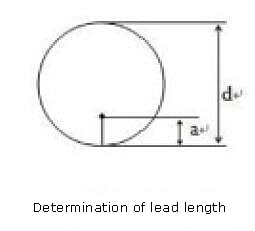
When cutting thick carbon steel (greater than or equal to 6mm), it is necessary to lengthen the lead to prevent the slag generated by blasting the hole from affecting the cut.
Acute angle cutting process
Causes of Acute Angle Burns
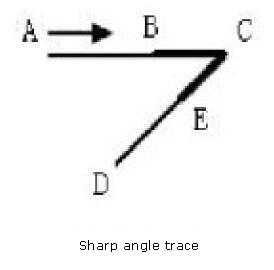
When the acute angle is cut, the machine axis goes through a process of deceleration and acceleration, and the speed changes, while the laser output power remains unchanged.
The laser energy concentrated at the corners is twice as high as the cutting line.
The corners will burn due to excess heat.
Acute Angle Processing Technique
In the laser cutting process, try to avoid sudden changes in speed and direction, as this will easily lead to local overheating of the workpiece, thus affecting the cutting quality.
Acute angles generally have the following processing methods:
1) Transition with circular arc
If there is no special requirement for the acute angle, it is generally possible to use the small arc R1-2mm to make the transition.
Changes in cutting speed and direction are effectively damped.
As shown below:

2) Excessive cut of closed contour transition
As shown in the figure, this adds a closed corner overcutting path as an additional procedure, so that the cutting speed and direction are not changed abruptly at the corners, so as to even out the heat everywhere, thus eliminating the sharp angle with crisp, crisp edges.
Now you know the 9 factors that affect the quality of laser cutting and the method to improve the quality of laser cutting.
For more details on laser cutting quality control, you can also check this article: Laser cutting quality control (with proven solutions)

























































